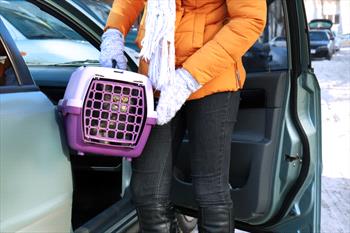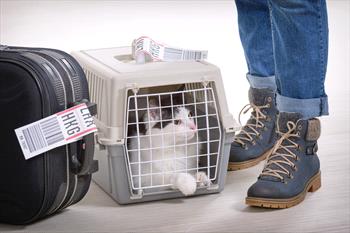Cat carrier into car

Photo courtesy of Depositphotos
Cats give new meaning to the experience of going somewhere with pets. The vast majority dislike any change that is not initiated by them, so for most cats, the only time they get into the car is to go the veterinarian. Going there might have become his worst nightmare.
The hardest part is that you have to figure out what works for each individual, so what you do for one cat may not work for his companions. A good trick is to let them get used to the carrier when you don’t need to go anywhere, just like a dog in a crate. Throw treats in there, or dinner, to acclimate him. If he only sees it when you are going someplace, he will likely get scared every time he sees it.
You can put synthetic facial marking pheromone spray, such as Feliway, in the carrier. It may help to use it in the room where the cat is before you begin.
Timing can be variable. If you have a veterinary appointment and need to leave on time, start getting him into a carrier earlier than you think you will need to; many cat owners have discovered too late that their cats are more uncooperative today than usual.
The most important step is locating him, and not losing sight of him. After you do, herd him into a small room. Bathrooms work best, given the limited real estate; in a bedroom, he can hide under the middle of a bed and vocalize his preference not to be removed. Get him into the same room with the carrier. Moving calmly and quietly will speed the process; if you get upset, your cat will likely get more upset. Liberal use of treats may help.
If you need to, wrap the cat in a towel so it’s easier to put him in the carrier. It will keep his outstretched legs and claws next to his body.
Put a comfy pad, towels, or blanket in there; it can help if you rub the item on your skin so it smells like you. He doesn’t need the added irritation of sitting on cold, hard plastic.
An easy approach is to bring the carrier into the room the cat is in, close the door, and reach for the cat. This approach is easiest if your cat is napping or half asleep rather than watching you alertly.
Sometimes it helps to have a second person assist you, one to encourage the cat to move out from where he is hiding, and the other to chase and corral him. People, even veterinarians (their cats are no more cooperative than yours), have used such items as broomsticks, Swiffer dusters, fireplace implements, and golf clubs to gently urge grumpy cats into the open. If you are alone, a hair dryer can help get cats out from under the bed.
Then you put him in the carrier. Some carriers are easier to do this than others. A favorite is a hard-plastic carrier with a top opening (like a roof) into which you can drop the cat and then shut the lid. In these, the space into which they go is larger than using the type that only opens on the ends, like barn doors. An additional plus is that the side walls are also plastic, giving the cat more of a feeling of being hidden than a wire carrier.
For loading into one with barn doors-type openings, stand the carrier on end and drop the cat into it vertically, bottom first. Cats seem less sure of what’s happening and less likely to argue with their claws if they can’t see where they’re going and feel like they’re falling backward. They may hold onto the door with their toes, which you will have to fuss with to get them to let go.
If your carrier has a top and bottom half, take the top off and quickly put the top back. This may be easier said than done with any type of carrier.
Another trick is that a couple of hours before you have to leave, bring the carrier into the room in which the cat is napping, leave the carrier in there and shut the door when you leave. After they are both in one room, you don't have to look for him in the basement and on the second floor.
If your cat tends to drool, vomit or defecate from nervousness or stress, talk to your veterinarian about medication, which may help. Medications are available for both motion sickness and travel anxiety; sometimes a combination is necessary. Some cats do better with different medications. Finding the right dose may take some time.
Airline carrier for cat

Photo courtesy of Depositphotos
In cold temperatures, your cat will likely appreciate a lot of warm padding in the crate, and possibly a blanket over the carrier to fend off wind and keep the interior as warm as possible.
Flying in an airplane with a cat starts out in a similar manner to getting the cat into the carrier, but long before you leave for your flight, confirm what kind of carrier is required by each individual airline you are taking. Don't assume that because a carrier is accepted by Airline A that Airline B will also accept it. You may need health paperwork from the veterinarian, and it may have to be done within a few days before the flight. If you do your homework, it should all go smoothly (well, smoothly as possible considering your cat will be far away from his comfort zone).
Getting your cat in the carrier may go very easily, and it might not. He might take it easier the first few times he goes to the veterinary clinic, and then ramp up his dislike. Talk to your veterinarian about what the best methods might be for your cat.
More information is available from CatVets and in this video by the CATalyst Council.